Designing Our Offices for Hybrid Work: What We Learned
8 key takeaways for designing the office for hybrid and optimizing the employee experience
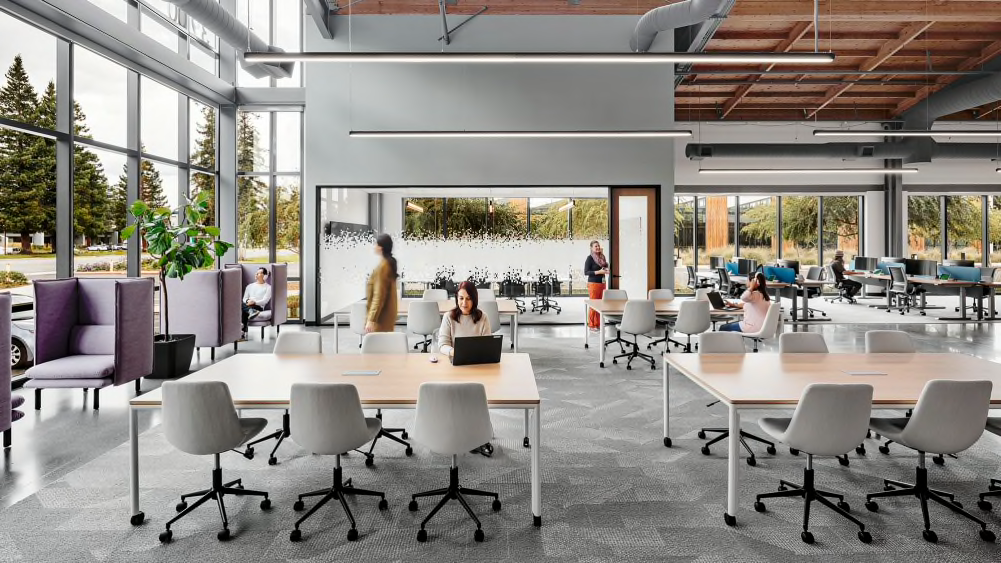
A Vision for the Hybrid Office
In early 2022, Logitech took the opportunity to rethink our real estate footprint to optimize for our newly hybrid workforce.
Our vision was to create a world-class environment for employees and customers, a place that would draw people together and allow them to experience our solutions and our brand ethos in an optimal way.
We pondered, would employees come back to the office? What would draw them back? And specifically, how could we leverage technology and data-driven insights to create a great employee experience?
“How do we make our employees’ commute worth it? We start with a complete overhaul on how we view and program space. We take a human-centric approach to design, asking ourselves how physical space can support culture, innovation, productivity, comfort and fun.”– David Houseman, Head of Workplace Experience, Logitech
For our new office in San Jose, California, we focused on three overarching goals:
1. Prioritize the employee experience to make the office an inspiring and desirable place to work. Ensure employees can be as effective and productive as possible.
2. Inspire teamwork, enabling employees to collaborate without friction, particularly with those in offices around the globe.
3. Embrace flexibility, enabling us to adjust to changes in workforce size and meeting room needs as they arise. We also wanted the flexibility to host onsite events.
We used learnings and data from recent redesigns of our offices in Lausanne, Switzerland, and Cork, Ireland to inform the San Jose approach. We looked at data and insights from actual office usage in these locations and examined employee behavior to guide our decision-making.
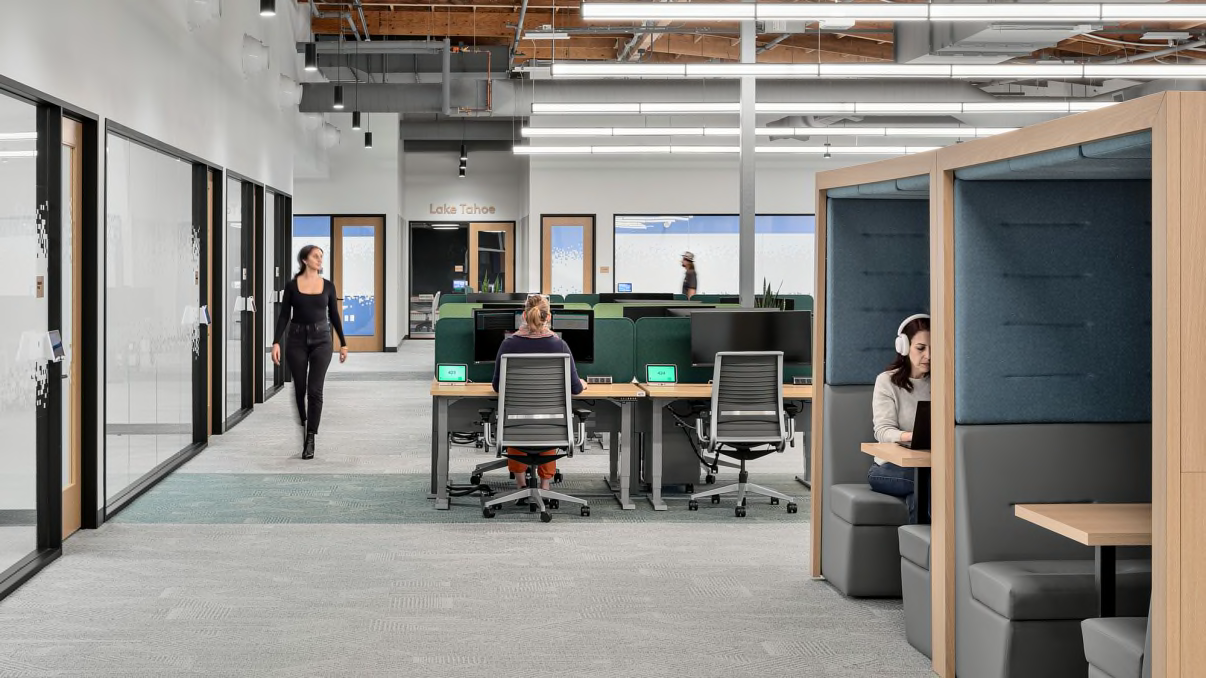
One of the many flexible desk areas and collaborative seating arrangements at the San Jose office.
Data-Driven Space Planning
We were able to visualize data and look at room and device usage trends using Logitech Sync, our remote device and space management software.
Sync leverages the AI Viewfinder capability in our Rally Bar and Rally Bar Mini cameras to detect meeting participants, allowing for “people counting,” even when the room system isn’t active for a video meeting. It offers reports on meeting room usage, including the number of people who use meeting rooms and which rooms are used the most, all displayed in the Sync dashboard.

Example of meeting room data in Sync.
We hypothesized that small rooms or huddle spaces would be used primarily for one-on-one meetings, but we noticed they were being used regularly for video meetings. In fact, every meeting room was used almost exclusively for video calls.
“Our Cork office was very much a test pilot for what we were going to do in San Jose. How many video pods would we need? How many medium style rooms? How many large collaborative spaces? So we relied heavily on insights. We began to look at new metrics.”– Michael Barry, Head of VC/B2B Acceleration, Logitech
We also learned we didn’t have the right ratio of small and large rooms. We thought larger rooms would be used for meetings with a lot of people, and we thought the typical conference room for 10-12 people would be the most popular. In a hybrid work environment, as it turns out, small spaces are in high demand. We didn’t have enough. As a result, our larger rooms were often occupied by one or two people because all the smaller rooms were booked.
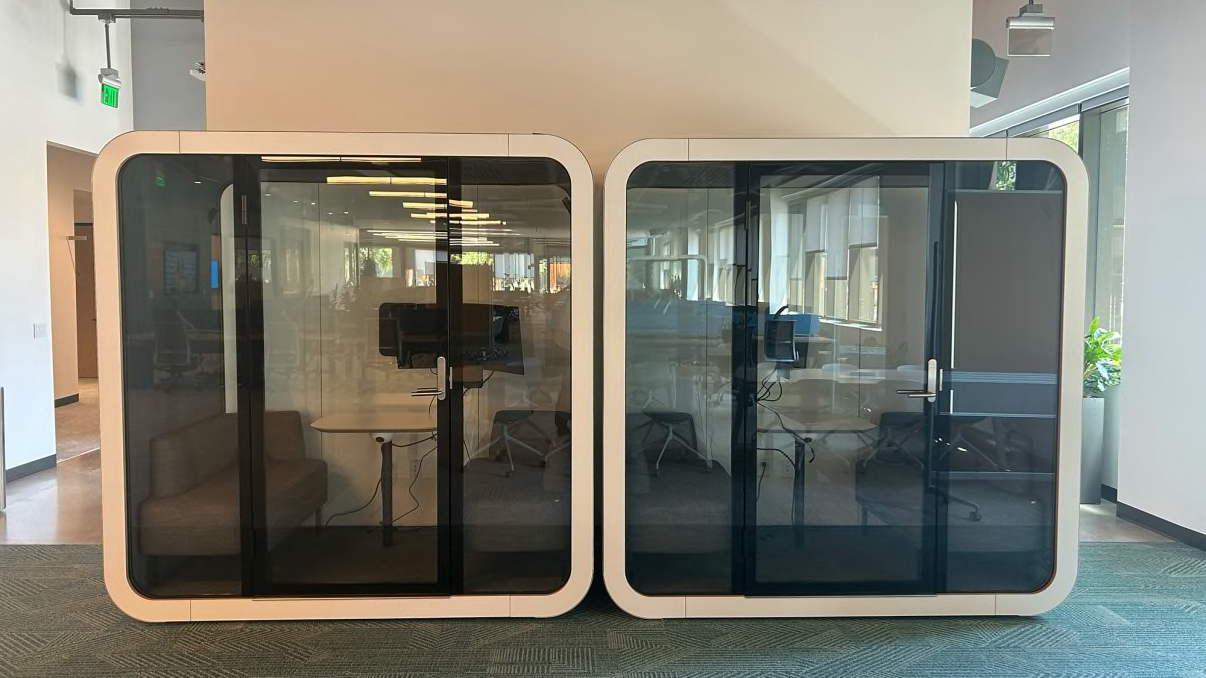
Soundproof phone booths equipped with Logi Dock Focus Room Kit.
So Here’s What We Actually Did
Ultimately, we decided to add a lot more huddle rooms and “video pods” and equipped them with Rally Bar Huddle cameras, which are purpose-built for these smaller spaces.
But importantly, we built in flexibility, making the rooms easy to modify so that we could change our meeting room configurations as we uncovered new insights. To do this, it was crucial to have workplace services and IT aligned early in the process.
These two teams worked together to ensure that rooms and spaces were as flexible as possible. That required advanced planning during the construction phase regarding how rooms were wired, for example. We opted for modular meeting pods over hardwall construction wherever we could, allowing for repositioning as needed. Now, even significant changes to the office may take a few days, rather than weeks or months.
“Listening to teams and taking real insights we get from our devices, we were able to actually conceive how we define our rooms and what technology we should put into them.”– Michael Barry, Head of VC/B2B Acceleration, Logitech
We also based decisions on usage data rather than booking data, such as which rooms were actually used, and how many people were actually in the room. We captured the data in Sync using Logitech Tap Scheduler and the AI Viewfinder in Rally Bar cameras.
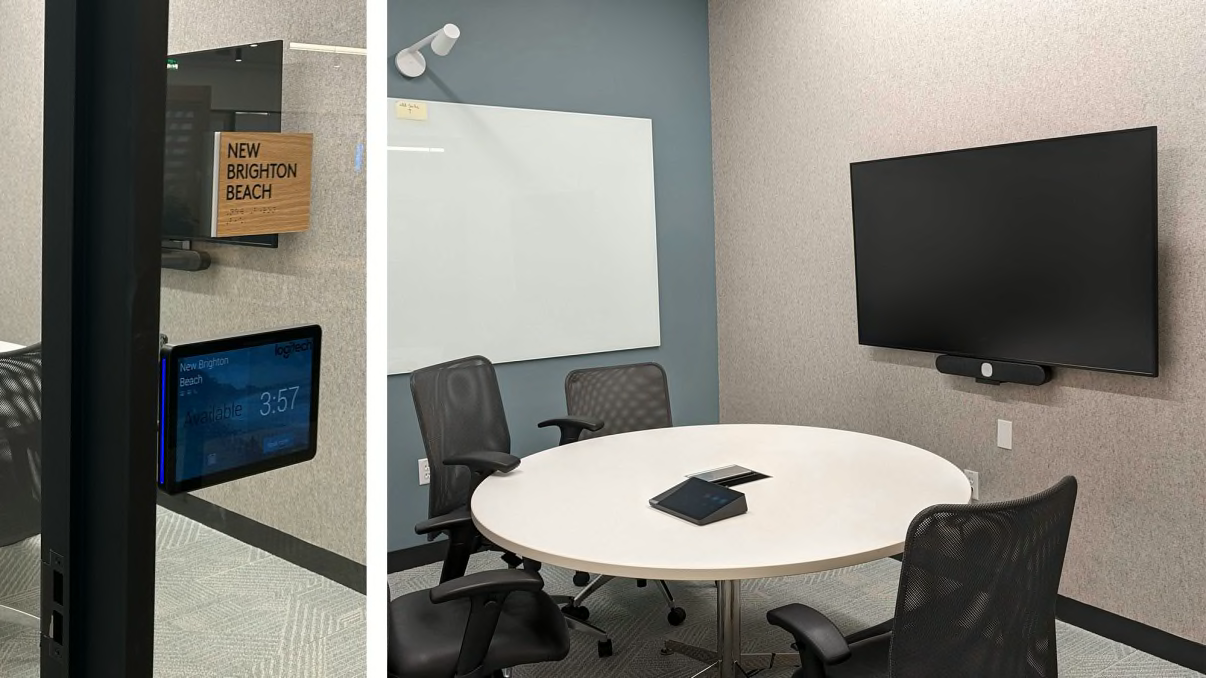
Huddle room equipped with Rally Bar Huddle, Scribe, Tap IP, and Tap Scheduler for easy check-in. If no one checks in, the room is released and becomes available to others.
In addition to optimizing meeting rooms, we became early adopters of our own flex desking products. This included Logi Dock Flex and our new Logitech desk booking software service.
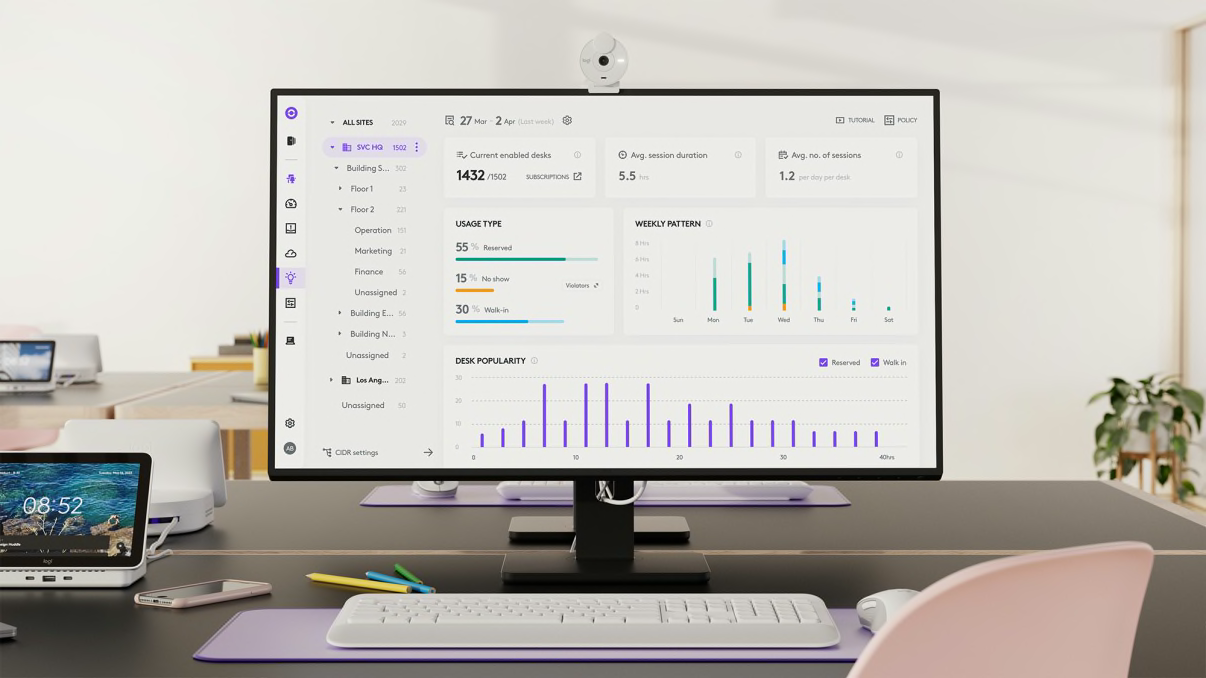
Logi Dock Flex and an example of what desk booking data looks like in Sync.
The inclusion of social network features in the desk booking software makes it easy for employees to notify coworkers about their plans to be in the office, so they can coordinate sitting together. Not surprisingly, people are more inclined to come to the office when coworkers will also be present.
The hardware/software combination of Logi Dock Flex and desk booking software allows employees to select a desk based on location or proximity to teammates and check in effortlessly when they arrive at the office by attaching their laptop with a USB-C cable. This provides us with the actual usage data, which we capture in Sync. And, as with meeting room data, we mine the data (actual check-ins rather than bookings) to look for trends that inform our future workspace strategy.
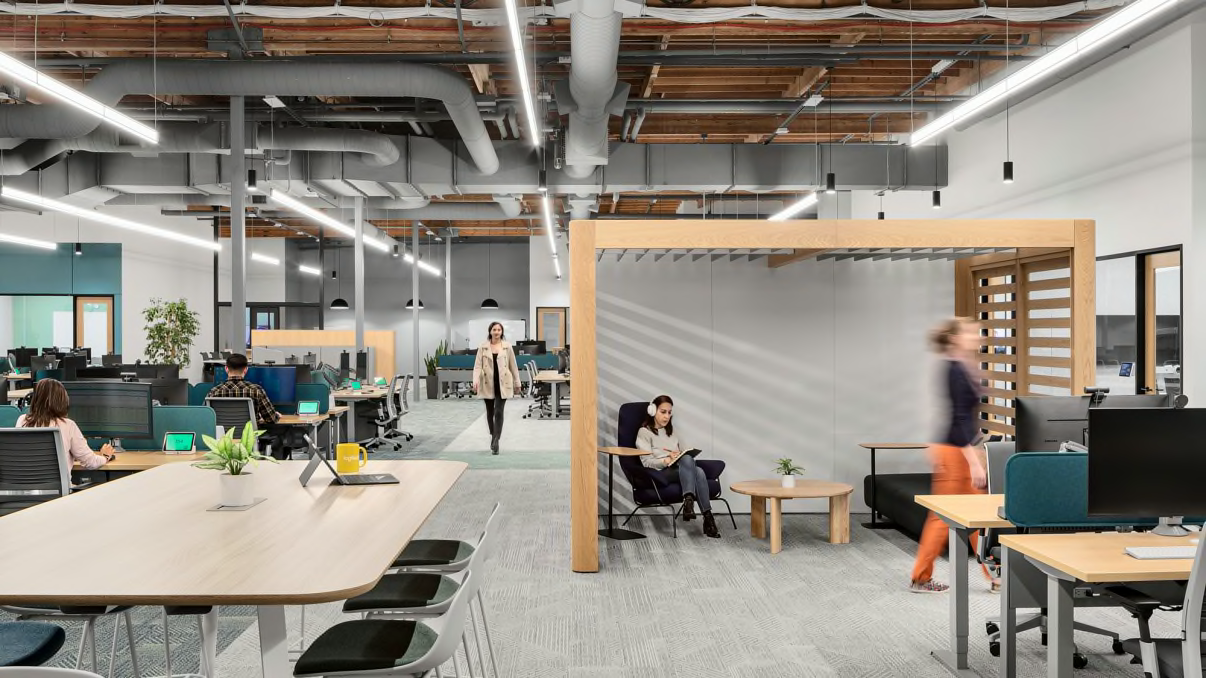
Looking Forward
Is our approach working? Well, it’s too early to tell.
We continue to be our own “living lab,” learning as we go and adjusting to a changing work landscape.
We’re deploying new office technologies and video conferencing quickly, with minimal time and effort. We modify meeting rooms as needed, and convert banks of desks into meeting spaces and vice-versa as we learn how employees use the space. And we’re using insights from Sync to guide our decisions.
So here are our eight key takeaways for designing the office for hybrid and optimizing the employee experience:
Adopt an agile mindset, experimenting, testing and learning as you go
Leverage technology for data-driven insights
Assume most spaces will be used for video calls, and plan accordingly
Align workplace services and IT early in the process
Build in flexibility where possible, making the rooms easy to modify so that as you uncover new insights, you can change meeting room configurations
Base decisions on usage data rather than booking data
Remove friction and enable employees to flow easily from home to office with desk booking software
Embrace the adventure!
If you find yourself navigating the complexities of hybrid design, we'd love to connect. Feel free to reach out and consider joining us for a tour of Logitech's San Jose office. Our journey is a work in progress, and we’d love to exchange insights.
Learn more about Sync insights in this article.
YOU MAY ALSO BE INTERESTED IN
Browse Categories: